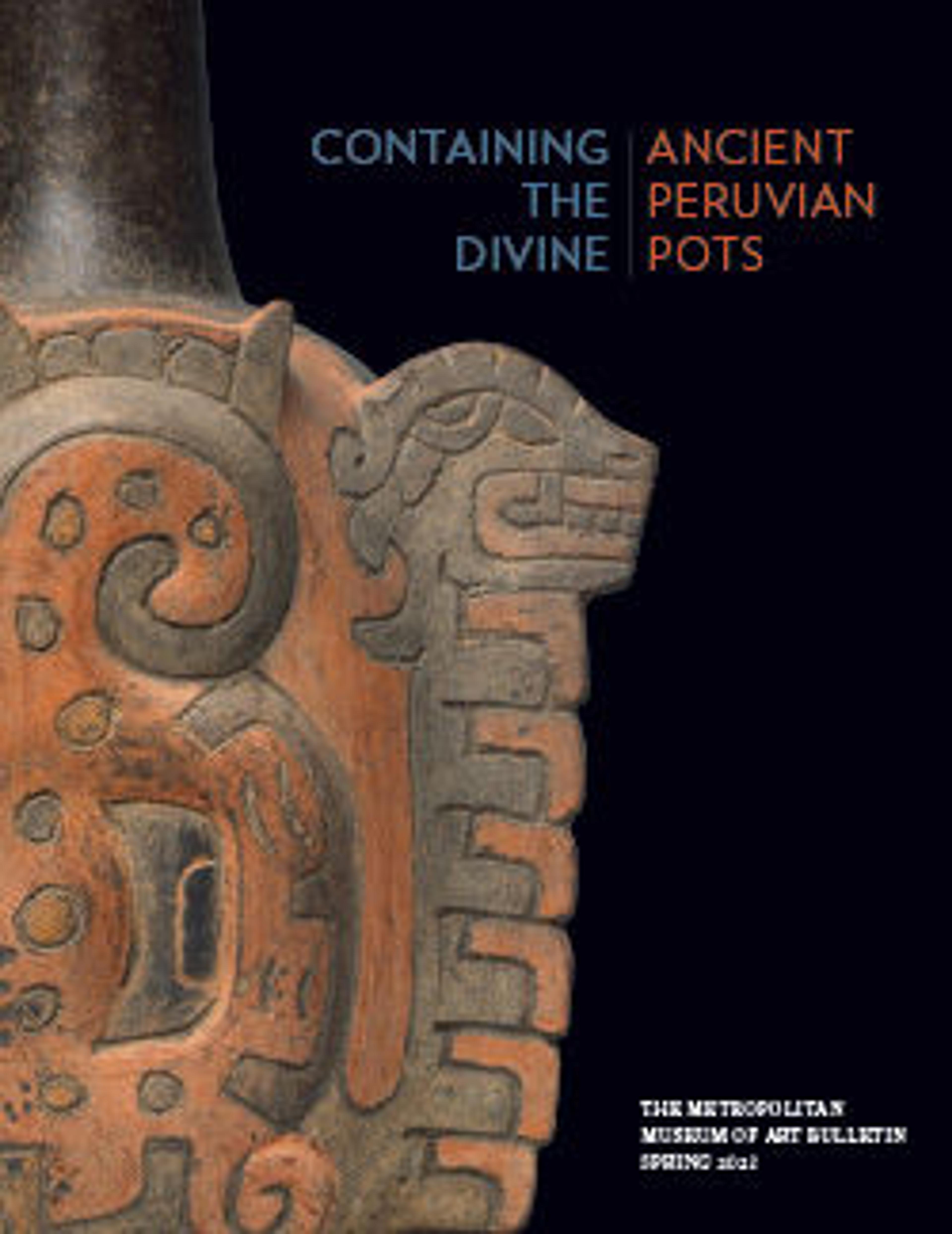Bottle with fang motif
This seemingly simple ceramic bottle with a fanged mouth is a shorthand reference to the complex iconography of the Cupisnique-Chavín religious tradition, which flourished in communities of the Peruvian North Coast between 1200 and 500 B.C. Cupisnique artists often combined features of felines, raptorial birds, and reptiles in a single figure, or they would reduce figures to their most salient features, such as on the present example, which can also be read as two fanged mouths in profile.
Cupisnique potters, who preferred a muted palette, usually the natural hue of the fired clay itself, enhanced the visual interest in their ceramics by creating contrasts between smooth and textured zones. On this vessel, the burnished sections—the lip of the bottle and the fanged mouth—underscore the conceptual link between two orifices, the mouth of the vessel and the mouth of a feline. By contrast, the rest of the vessel’s body is covered with a textured, teardrop-shaped pattern created with the tip of a rounded tool pushed against the soft clay.
Fangs are symbolic of predation, reminders of a natural order that is determined by who eats whom. Stone sculptures at Chavín de Huántar, one of the most important ceremonial centers in the Central Andes during the first millennium B.C., depict supernatural beings with fangs, beaks, claws, and talons—elements of multiple predators—suggesting an all-powerful being.
Hugo C. Ikehara-Tsukayama, Andrew W. Mellon Curatorial/Collection Specialist Fellow, Arts of the Ancient Americas, 2022
Further Reading
Burger, Richard L. Chavin and the Origins of Andean Civilization. London: Thames and Hudson, 1992.
Burtenshaw-Zumstein, Julia T. Cupisnique, Tembladera, Chongoyape, Chavín? A Typology of Ceramic Styles from Formative Period Northern Peru, 1800-200 BC. Unpublished PhD dissertation. Norwich: University of East Anglia, 2014.
Ikehara, Hugo C. "Multinaturalismo y perspectivismo en los centros ceremoniales formativos." In Los desafíos del tiempo, el espacio y la memoria: Ensayos en homenaje a Peter Kaulicke, edited by R. Vega-Centeno and J. Dulanto. Lima: Fondo Editorial Pontificia Universidad Católica del Perú, 2020.
Rowe, John H. Chavin Art: An Inquiry into its Form and Meaning. New York: The Museum of Primitive Art, 1962.
Weismantel, Mary. "Seeing Like an Archaeologist: Viveiros de Castro at Chavín de Huantar." Journal of Social Archaeology 15, No 2 (2015), pp. 139-59.
Cupisnique potters, who preferred a muted palette, usually the natural hue of the fired clay itself, enhanced the visual interest in their ceramics by creating contrasts between smooth and textured zones. On this vessel, the burnished sections—the lip of the bottle and the fanged mouth—underscore the conceptual link between two orifices, the mouth of the vessel and the mouth of a feline. By contrast, the rest of the vessel’s body is covered with a textured, teardrop-shaped pattern created with the tip of a rounded tool pushed against the soft clay.
Fangs are symbolic of predation, reminders of a natural order that is determined by who eats whom. Stone sculptures at Chavín de Huántar, one of the most important ceremonial centers in the Central Andes during the first millennium B.C., depict supernatural beings with fangs, beaks, claws, and talons—elements of multiple predators—suggesting an all-powerful being.
Hugo C. Ikehara-Tsukayama, Andrew W. Mellon Curatorial/Collection Specialist Fellow, Arts of the Ancient Americas, 2022
Further Reading
Burger, Richard L. Chavin and the Origins of Andean Civilization. London: Thames and Hudson, 1992.
Burtenshaw-Zumstein, Julia T. Cupisnique, Tembladera, Chongoyape, Chavín? A Typology of Ceramic Styles from Formative Period Northern Peru, 1800-200 BC. Unpublished PhD dissertation. Norwich: University of East Anglia, 2014.
Ikehara, Hugo C. "Multinaturalismo y perspectivismo en los centros ceremoniales formativos." In Los desafíos del tiempo, el espacio y la memoria: Ensayos en homenaje a Peter Kaulicke, edited by R. Vega-Centeno and J. Dulanto. Lima: Fondo Editorial Pontificia Universidad Católica del Perú, 2020.
Rowe, John H. Chavin Art: An Inquiry into its Form and Meaning. New York: The Museum of Primitive Art, 1962.
Weismantel, Mary. "Seeing Like an Archaeologist: Viveiros de Castro at Chavín de Huantar." Journal of Social Archaeology 15, No 2 (2015), pp. 139-59.
Artwork Details
- Title:Bottle with fang motif
- Artist:Cupisnique artist(s)
- Date:800–550 BCE
- Geography:Peru
- Culture:Cupisnique
- Medium:Ceramic
- Dimensions:H. 7 in. (17.8 cm)
- Classification:Ceramics-Containers
- Credit Line:Gift of Judith Riklis, 1983
- Object Number:1983.546.12
- Curatorial Department: The Michael C. Rockefeller Wing
More Artwork
Research Resources
The Met provides unparalleled resources for research and welcomes an international community of students and scholars. The Met's Open Access API is where creators and researchers can connect to the The Met collection. Open Access data and public domain images are available for unrestricted commercial and noncommercial use without permission or fee.
To request images under copyright and other restrictions, please use this Image Request form.
Feedback
We continue to research and examine historical and cultural context for objects in The Met collection. If you have comments or questions about this object record, please contact us using the form below. The Museum looks forward to receiving your comments.
